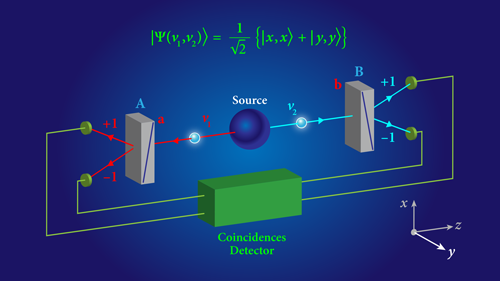Quantum Study Suggests ‘Spooky Action’ Is Real (no loopholes)
The results of a new experiment, to test Bell-like inequality violations, was released in Nature magazine. This study closes nearly all logic-loopholes that have been hypothesized in many prior experiments. In a sense, this is old news. The non-local results have been fairly universally accepted since the 1970s.
Article in New York Times:
excerpt:
In a landmark study, scientists at Delft University of Technology in the Netherlands reported that they had conducted an experiment that they say proved one of the most fundamental claims of quantum theory — that objects separated by great distance can instantaneously affect each other’s behavior.
link:
Sorry, Einstein. Quantum Study Suggests ‘Spooky Action’ Is Real
The article is at:
Loophole-free Bell inequality violation using electron spins separa...
Tags:
Replies to This Discussion
-
ModeratorPermalink Reply by John on December 27, 2015 at 12:21pm -
Further information:
There is a Viewpoint article I found at APS (American Physical Society):
excerpt:
By closing two loopholes at once, three experimental tests of Bell’s inequalities remove the last doubts that we should renounce local realism. They also open the door to new quantum information technologies. ...
Figure 1: An apparatus for performing a Bell test. A source emits a pair of entangled photons and . Their polarizations are analyzed by polarizers A and B (grey blocks), which are aligned, respectively, along directions a and b. (a and b can be along x, y or any direction in the x-y plane; here, they are along x.) Each polarizer has two output channels, labeled +1 and -1. A photon polarized parallel (perpendicular) to a will emerge in +1 (-1) at A. Similarly, a photon polarized parallel (perpendicular) to b will emerge in +1 (-1) at B. But in general, the photons are not in a state of polarization corresponding to a specific output channel, and then the formalism of quantum mechanics yields the probabilities of getting results +1 or -1, for specified orientations of the polarizers. For the entangled state of two polarized photons shown here, the quantum formalism predicts random results on each side (a 50% probability of being +1 or -1.) But it also predicts strong correlations between these random results. For instance, if both polarizers are aligned along the same direction (a=b), then the results at A and B will be either (+1,+1) or (-1,-1), but never (+1,-1) or (-1,+1): this is a total correlation, as can be determined by measuring the four rates with the fourfold detection circuit (green). Local realism explains these correlations by assuming a common property of the two photons, whose value changes randomly from one photon pair to the next. Bell’s inequality, however, shows the correlations predicted by local realism are limited; but quantum predictions violate this inequality. A Bell test consists of measuring the correlations and comparing the results with Bell’s inequalities. To perform an “ideal” Bell test, the polarizer settings must be changed randomly while the photons are in flight between the source and the polarizers, and the detector efficiencies should exceed 2/3 (see text for details).
Viewpoint Article: Closing the door on Einstein and Bohr's Quantum Debate
The three papers referred to are:
B. Hensen et al., “Loophole-free Bell Inequality Violation Using El...
M. Giustina et al., “Significant-Loophole-Free Test of Bell's Theor...
L. K. Shalm et al., “Strong Loophole-Free Test of Local Realism,” P...
>> >> >>
just fyi: the Science statement below, propagated by the dogmas that Sheldrake promotes himself with is totally wrong:
1. Everything is mechanical; only mechanistic explanations will do.
>> Above (local-realism) has been known, experimentally, as false since the 1970's. Sheldrake is ignorant, it seems.
-
-
ModeratorPermalink Reply by John on August 31, 2018 at 5:57pm -
Einstein lost the EPR paradox. Quantum Mechanics won. i.e.There is no local realism.
Test of Local Realism into the Past without Detection and Locality Loopholes
Conclusion:
"In conclusion, we perform a null hypothesis test which rejects local hidden variable models taking place as early as 11 years before the experiment with high confidence. Looking into the future, our experiment may serve as a benchmark to progressively rule out local hidden variable models deep into the cosmic history by utilizing the randomness in quasars of high redshift or even cosmic microwave background in future experiments. Further, we may find interesting applications in device-independent quantum information processing. Scaling up the spacetime extension in the local realism test is being actively pursued. The same system may also help to examine the hypothesis for human free choice and gravitational effect and to address collapse locality loophole."
Link to actual paper:
https://arxiv.org/pdf/1808.07653.pdf (not for the faint of heart)
-- -- -- --
Cosmic Bell Test Using Random Measurement Settings from High-Redshift Quasars
Dominik Rauch, Johannes Handsteiner, Armin Hochrainer, Jason Gallicchio, Andrew S. Friedman, Calvin Leung, Bo Liu, Lukas Bulla, Sebastian Ecker, Fabian Steinlechner, Rupert Ursin, Beili Hu, David Leon, Chris Benn, Adriano Ghedina, Massimo Cecconi, Alan H. Guth, David I. Kaiser, Thomas Scheidl, and Anton Zeilinger
Phys. Rev. Lett. 121, 080403 (2018) – Published 20 August 2018
Extract from paper's abstract:
In this paper we present a cosmic Bell experiment with polarization-entangled photons, in which measurement settings were determined based on real-time measurements of the wavelength of photons from high-redshift quasars, whose light was emitted billions of years ago; the experiment simultaneously ensures locality. Assuming fair sampling for all detected photons, and that the wavelength of the quasar photons had not been selectively altered or previewed between emission and detection, we observe statistically significant violation of Bell’s inequality by 9.3 standard deviation
Actual Paper:
https://arxiv.org/pdf/1808.05966.pdf (not for the faint of heart)
-
© 2025 Created by Theosophy Network.
Powered by
![]()
